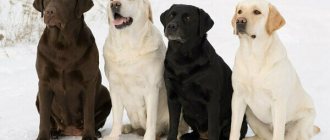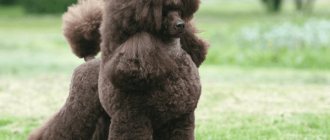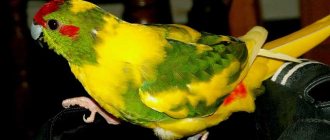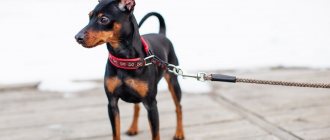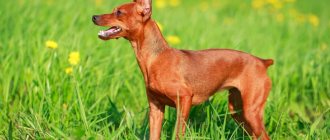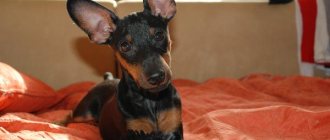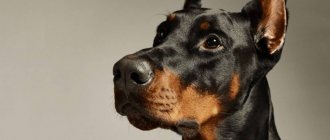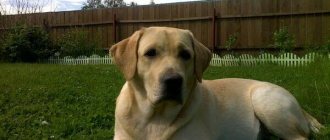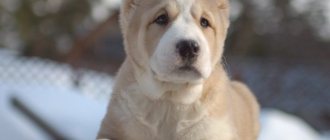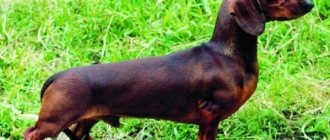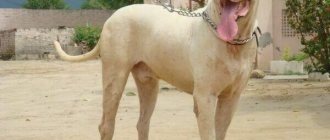Description of the breed
Dogs of this breed are small in stature, but despite this they are classified as service dogs. At the withers, the miniature pinscher reaches 25 cm, and its weight rarely exceeds 6 kg. Small dogs perfectly perform any duties and cope with a huge number of tasks. They belong to the category of the smallest guard dogs.
Their energy and tirelessness have made miniature pinschers favorite pets. It is difficult not to notice the similarity between the miniature pinscher and the Doberman. In fact, there is no relationship between them, although it was pinschers that inspired breeders to develop a larger breed with the same characteristics.
If you want to have not only a small pet, but also devote a lot of time to training, the miniature pinscher is perfect for you. Thanks to a high level of intelligence, excellent memory and quick wits, the Miniature Pinscher loves to learn and retains a lively character until old age.
German Pinscher: description
These are proportional, compact animals with a light build and dry constitution. The height of an adult varies between 43-58, and the weight can reach 12-16 kilograms. On an elongated, narrow-muzzled head with a weakly defined stop, there are dark, shiny eyes and high-set, hanging or cropped ears.
The short neck of the German Pinscher smoothly transitions into prominent withers, a strong, flat back and a short, slightly lowered croup, ending with the base of a saber-shaped tail. Under the well-muscled body there are two pairs of straight, thin-boned limbs.
The entire body of representatives of this type of pinschers is covered with straight, hard, shiny, tight-lying guard hair with practically undeveloped undercoat. The color of these dogs can be marbled, one- or two-color. In the latter case, on the main black background there are symmetrical, clearly defined red or mahogany tan marks. As for single-colored individuals, their shade is often compared to the color of a reddish deer or chamois.
Miniature Pinscher breed standard
These dogs not only repeat the German Pinscher breed standard in miniature, but also lack many of the disadvantages inherent in dwarf breeds.
The Miniature Pinscher breed was bred in Germany and belongs to the category of domestic dogs.
Its description will be incomplete without indicating the basic proportions:
- the ratio of body length to height is almost the same, which makes these dogs almost square;
- The length of the body from tail to withers is approximately equal to twice the length of the head.
The Miniature Pinscher is a smooth-haired dog. The temperament is lively, the character is balanced, thanks to which the pet has taken its rightful place in the list of the best family dogs.
The head is oblong. The nose is pigmented black, like the lips, the lobe is well developed. Scissor bite, strong. The jaws are developed, but do not interfere with the straight lines of the head.
The neck is of medium length, without sagging folds of skin, and has an elegant appearance. The back and chest are strong. The tail is of medium length, a sickle or saber shape is allowed.
The hind and forelimbs are straight and strong. The dog moves confidently and smoothly, while the back remains straight. The coat is very thick and smooth, with a noticeable shine.
The following colors are allowed: sand, black and tan, brown (with or without tan), gray-blue, solid red.
What is the color and color of German Pinscher dogs?
The visible pigment of the outer part of the hair. A significant number of dogs, along with pigmented hair, have white spots or marks in certain areas of the body that are devoid of pigment, i.e. hair lacking pigment. When mixing colors, the color of the dog is determined by the dominant color. A dog has such types of hair as downy, integumentary (smooth), guard hair. The different properties of wool are determined as an adaptation to different climatic conditions and their habitat. Each type of coat and its color requires special care. Breeders have studied how color and patterns are created on the body of an animal. Genes can be responsible for hair structure and color. This is general information that applies to all dog breeds and does not apply to German Pinscher puppies.
- A. With the help of this locus, a solid color of the pet’s entire body is obtained (monochromatic).
- B. Dyes wool black. Some species have partial of this gene (spotting). Some dog breeds necessarily have this gene!
- C. This is the key component! With its help, the body produces color throughout the body. If this component is missing, the dog may be born without color (albino). The color of the nose and iris does not depend on this component.
- D. If there is little gene in the pet’s body, then the coat will be lighter. If there is a lot of gene in the body, then the dog will have a rich black color. The gene affects the viability of the dog; if a pet is born with a lack of the gene and a blue color, then he may most likely not live to see his senior years. When the gene is dominant, the color of the pet turns out to be black.
- G. With old age, this component is activated and gray hair appears. They call him gray-haired. When the color turns gray.
- E. With its help, in most cases, three-color colors are obtained, containing pigment of black, brown and yellow.
- M. The gene leads to anomalies for the pet and gives a harlequin pattern. Has a marble color. With old age, the gene can lead to lightening of color.
- S. This gene causes partial body pigmentation in dogs. (white spotting).
- T. The gene is characterized by mottling. It is opposite to the S gene and forms dark spots on white areas.
- R. Chastity - alternation of hair that is colored and not.
Character and characteristics of the miniature pinscher
The Miniature Pinscher is an excellent watchdog. His qualities are not inferior to the professional skills of service dogs. The miniature dog is very playful, active and needs strong physical activity. Without long walks, he may become bored, aggressive, or mischievous.
Psychological characteristics of the miniature pinscher breed:
- courage;
- independence;
- bravery;
- distrust of strangers
- need for personal space;
- energy;
- easy training, possibility of sports training in many formats (agility, freestyle, etc.);
- tendency to bark frequently, loud voice.
If you get a miniature pinscher, pay close attention to its training and socialization. Remember: the Pinscher is not a toy dog and needs training and walks. The breed is not recommended for people who have not owned a dog.
Care and maintenance of the miniature pinscher
The Miniature Pinscher is a small short-haired dog with the habits of an adult guard breed. First of all, you need to provide her with sufficient space to play, allocate a place to sleep and take an active part in socialization.
The Pinscher's coat does not require special care, but it does not protect him from frost. In winter, your pet will need a warm jumpsuit. Clothing for dogs is sold in specialized stores, or you can sew it yourself. In severe frosts, you will also need boots, because your pet's paws freeze quickly.
In hot weather, do not leave your dog in direct sunlight to avoid heat stroke. If you need to spend a lot of time in the sun, try to wet your Pinscher's coat with cold water.
Without long walks and games, a miniature pinscher can become fat. Even litter box trained pets need active play. If you leave your pet alone for a long time, he can find something to do on his own, adapting your things for his toys.
You don't need to bathe miniature pinschers too often. After bathing, there is a high risk of your pet catching a cold.
The small weight of the Pinscher does not allow the claws to wear down during a walk. From time to time you need to shorten them with special tweezers.
Content Features
This miniature breed is ideal for living in urban environments. This dog takes up very little space and practically does not shed. Another significant advantage of tiny animals is their unpretentiousness and cleanliness.
A miniature pinscher, the price of which ranges from 10-30 thousand rubles, does not need frequent washing or regular combing. You need to bathe such a dog as rarely as possible, since there is a high risk of catching a cold. You should also systematically trim your pet’s claws, because they do not have time to wear down naturally.
During walks, it is better not to let such a baby off the leash so that he is not accidentally injured by passers-by or other dogs. In winter, before leaving the house, the animal must be dressed in insulated overalls.
Feeding the miniature pinscher
All owners wonder what to feed their miniature pinscher. Natural feeding is preferable for these dogs.
A balanced diet should include the following foods:
- beef (any red meat is suitable, including horse meat);
- a mixture of vegetables (zucchini, cucumber, pepper, pumpkin, carrots);
- dairy products (sour cream, cottage cheese);
- porridge (rice, wheat, buckwheat);
- seafood;
- articular bones in raw form;
- berries (you can give everything except grapes).
It is very important to monitor the condition of your pet and not overfeed it. The Pinscher loves to eat, and owners often spoil their pets by offering them too much food.
Under no circumstances should you give your dog fatty foods. This is not only the first step to obesity, but also difficult work for the liver. Sweets are also contraindicated. If you want to pamper your pet, give him some sweet fruits. It is strictly forbidden to add spices and salt to food.
Miniature Pinscher puppies
In order for your pet to grow into a beautiful, intelligent miniature pinscher, you need to devote enough time to raising it. If you do not have dog training skills, contact a trainer. He will tell you the main character traits of miniature pinschers and how to interact with them.
The puppy's diet should be rich in calories and calcium. Before bringing your pet home, talk to the breeder. What the puppy was fed before should be his diet for at least another week. This way you will simultaneously alleviate the stress of moving to a new home and eliminate rejection of the new menu.
If you decide to feed your baby dry food, choose a special one for small breed puppies. The food must meet all standards and be at least premium. This is the only way to achieve a harmonious diet for your dog.
Bad food will not only clog the stomach, but will also not provide the animal with all the necessary substances and microelements, which are the basis for future health. A lack of calcium will affect the development of the musculoskeletal system, and a lack of protein will affect the general condition of the growing body.
Until 4 months of age, dry food should be soaked in a small amount of water. Be sure to place a bowl of clean drinking water nearby and refresh it daily.
A puppy from 2 to 6 months needs four feedings a day, after 6 and up to 9 months - three times a day, and after 9 months of age, a miniature pinscher can switch to an adult diet twice a day (morning and evening).
Miniature Pinschers Training
The sooner you start training your Miniature Pinscher puppy, the better. Despite the fact that these dogs have long since turned into indoor dwellers, their guard and security qualities are still preserved in their blood. And if education is not addressed in time, these qualities can develop into territorial aggression.
Pinschers learn easily and with pleasure. Their inquisitive mind will not let you get bored. The desire to be a leader sometimes forces him to enter into confrontation with the owner for the role of leader. The main thing is not to succumb to their cute appearance and not give in.
During training, inexperienced owners may experience minor difficulties. Because of their curiosity, Pinschers often get distracted. Therefore, it may seem that they are disobedient. Under no circumstances should you punish your dog. You need to approach the education process creatively, reward good work and not lose patience in case of failure.
If you wish, you can find many videos that have more detailed recommendations for training miniature pinschers.
Miniature pinschers are very active, so it is advisable to help them remove the accumulated emotional charge. Walk them more often, and do the walks over longer distances.
Miniature Pinscher training
Animal training begins at approximately 4-6 months. However, this does not mean that until this age the puppy should freely take advantage of your weaknesses and take advantage of your kindness.
You need to determine the miniature pinscher’s place in the house, show him his toys and not let him chew things. The sooner you start training your dog, the easier it will be to establish contact with it in the future. Active and energetic pinschers can cause real bedlam in a house where everything is allowed.
Training miniature pinschers is to ensure that he not only knows his name, but also:
- knowing your place;
- exclusion of property damage;
- prohibition on picking up food from the ground;
- leash training;
- in adulthood, knowledge of the “come to me” command.
The puppy also needs socialization, i.e. accustoming to life in society. He should not be afraid of the street, react aggressively to other people, or chase cats. Insistently scold your pet if he does something wrong, but do not allow yourself to be abused.
Miniature pinschers have quite a strong character, so if you do not want to raise a domestic tyrant, do not follow your pet’s lead, but show who is the master of the pack. Daily games, training and walks will help you better understand your pet's habits and win him over.
Peculiarities
The Doberman Pinscher is a dog completely unsuited to life in an enclosure. Since she has no undercoat, she only needs to be kept indoors, because in winter she will simply freeze. Caring for any representative of this breed comes down to regular examination of the teeth, claws, ears and eyes. Once a week, the animal should be cleaned with a special glove or a soft brush. It is advisable to bathe your dog using a special shampoo. Moreover, it is recommended to do this no more than twice a year.
Dobermans are not prone to allergies. Therefore, you can feed them with both natural and industrial food. In the first case, a couple of times a year you need to additionally give your pet a vitamin and mineral complex that contains seaweed.
It is necessary to walk such a dog regularly and for a long time so that it can splash out the accumulated energy. In winter, before going outside, it is recommended that your dog wear insulated overalls.
History of the breed
Representatives of this breed were first bred in Germany. Mention of pets similar to miniature pinschers was noticed back in the 15th century, but there is no exact evidence of the existence of these particular dogs at that time.
It is believed that the first miniature pinschers were bred in Württemberg. At that time, small dogs were assistants in almost all jobs.
They did an excellent job of catching rats, guarding stagecoaches, running along with horses. The excellent qualities of the breed were noted by many dog handlers of those times, which was the first step towards the development of the breed.
Half a century later, the miniature pinscher won the recognition of many dog lovers, and the famous dog handler Ernest Kniess organized the world's first exhibition of miniature pinschers in Leipzig.
The second country that fell in love with small brave dogs was America. Americans quickly recognized miniature pinschers and made a great contribution to popularizing the breed.
After World War II, France joined the fanciers of these dogs, followed by many European countries.
Now the miniature pinscher is considered one of the most capable dogs among its miniature brothers.
Super-star natural branch
Civil servant Friedrich Louis Daubermann comes from the “green heart of Germany”, Thuringia. While working as a night watchman, a small tax inspector cherished the dream of a reliable partner: a sharp-toothed, unpretentious security guard and protector. At a certain point, dreams and reflections resulted in concrete work: the farm premises were purchased for a kennel, dogs of various breeds were purchased. The standard German Pinscher was used as the base phenotype. The excellent genetic material was mixed with the blood of Greyhounds, Rottweilers, Great Danes, and Eastern Shepherd Dogs through interbreed matings.
As a result, it was planned to get a large, strong and swift warrior dog with good instincts and endurance. Great attention was paid to personal and intellectual parameters: the “dream dog” had to be able to work individually and make independent decisions.
The work was crowned with success: the ideal “gendarme dog” was created, an intelligent, powerful and very fast dog, capable of picking up the trail of an intruder, pursuing the criminal for a long time and tenaciously, and enthusiastically taking part in the arrest.
Presented at the “Doberman police dog” exhibition, the “terrier from Thuringia” created a real sensation: there were queues for puppies, the dog was in great demand.
After the death of the creator of the breed, “service dogs from Thuringia” were renamed Dobermans, and the “finishing” of the phenotype continued. No special attention was paid to the exterior; the main efforts were aimed at “softening” the temperament, stopping excessive aggressiveness and malice.
In 1960, Dobermanns (as a breed group Pinscher family ) received recognition from the World Canine Federation. World expansion took place quickly and without much difficulty. Doberman: a high-quality, modern and really in-demand product. Its fast-paced, sporty look is easily recognizable anywhere on the planet. Undeniable working qualities: the Doberman is a true style icon of service and guard dog breeds. Lean dogs are used by police and intelligence services, security agencies. Despite the image of “devil dogs”, “aggressive and bloodthirsty creatures” imposed by cinematic Hollywood, Dobermans are happy to be owned as a city, family dog. Pinschers can be vicious and aggressive, but this is a manifestation of working qualities, controlled condition. In “peacetime,” Dobermans fit perfectly into the family hierarchy, have good-natured contact with household members, and treat children with gentleness and reverence. In the family of a resident of a modern metropolis, the Doberman is a faithful companion and a reliable protector of life and property.
Interesting facts about the breed
All representatives of this breed are distinguished by an unusual gait for dogs, reminiscent of a trotter. This is why these dogs are sometimes called the "poor man's riding pony."
The Miniature Pinscher is an excellent watchdog. His hearing is so sensitive that he perfectly hears the rustling of leaves and the quietest sounds inaccessible to human perception.
This little dog knows who belongs and who doesn’t, and is well versed in protecting its owners. This particular pet is also called the “king of small dogs.”
Breed varieties
Doberman Pinscher: description of the dog breed, what it looks like
During the selection process, dog breeds were divided into smooth-haired and rough-haired animals. The wire-haired ones were called “schnauzer”, the smooth-haired ones were called “pinscher”. According to height ranking, dogs are divided into varieties:
- simple – height at withers up to 50 cm;
- small – height at withers up to 30 cm;
- large – height at withers up to 72 cm.
Each of them became an independent breed. The small one was called the “Miniature Pinscher”, the large one – the “Doberman Pinscher”.
Prices for miniature pinscher puppies
How much does a small miniature pinscher cost? Depending on the place of purchase and the pedigree of the dog, the price of a puppy varies significantly. For example, a dog with a pedigree, suitable for exhibition and breeding, can cost from 30 thousand rubles. Purebred pinschers that have a slight defect in their exterior can cost 15-20 thousand in a well-known nursery.
If this price does not suit you, you can also purchase a pet on Avito. But he most likely will not have documents, and the breed itself may be in question. Hand puppies usually reach prices of 10 thousand, or even less.
Before purchasing, be sure to find out more information about the breed, check the nursery, read reviews about it. A dog purchased from a good breeder will be healthier, better trained, accustomed to people, and will not show signs of aggression in the future. Breeders care about the quality of food for puppies, invite a veterinarian for vaccinations, and the puppies themselves grow up in an acceptable atmosphere.
Naturally, all this affects the final price of the animal. But the high price is a kind of guarantee that the dog will be in good hands of people who did not spare a certain amount for it. Buying a pet at a poultry market is not the best idea.
Almost always, such puppies turn out to be mestizos and can inherit some genetic diseases. But even if you bought a miniature pinscher from your own hands, care and affectionate attitude will make him the most devoted friend and companion.
Source: https://vetsystem.ru/porodi_sobak/tsvergpincher/
Austrian Pinscher: description
These are stocky, not too large animals with a wide, barrel-shaped chest and a powerful neck. Depending on the sex, the height of an adult is 42-50 cm, and the weight varies between 12-18 kg. The pear-shaped head with a short muzzle and well-defined stop has large dark eyes and triangular drooping or erect ears.
The dog's powerful neck smoothly transitions into prominent withers, a short back and an even croup, ending with the base of a high tail curled into a ring. The entire body of the animal is covered with straight, smooth hair of red, brownish-yellow, fawn or black with white or reddish markings.
